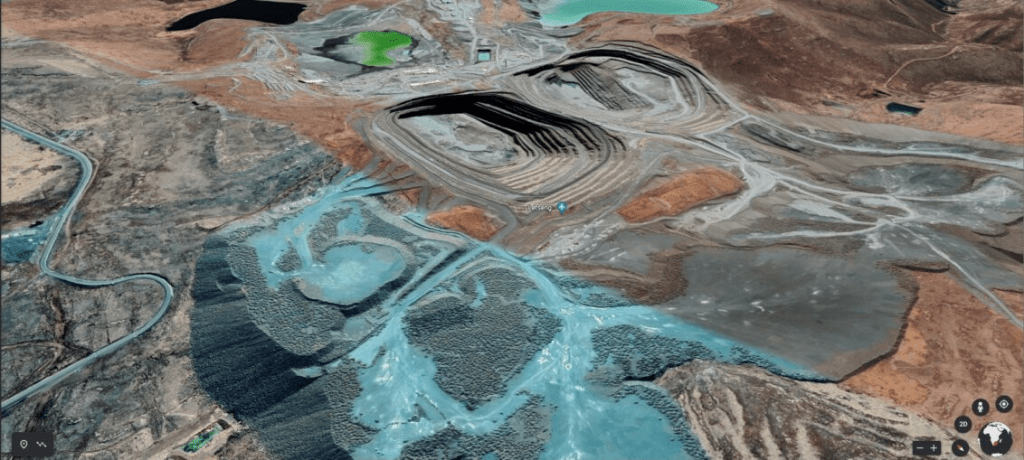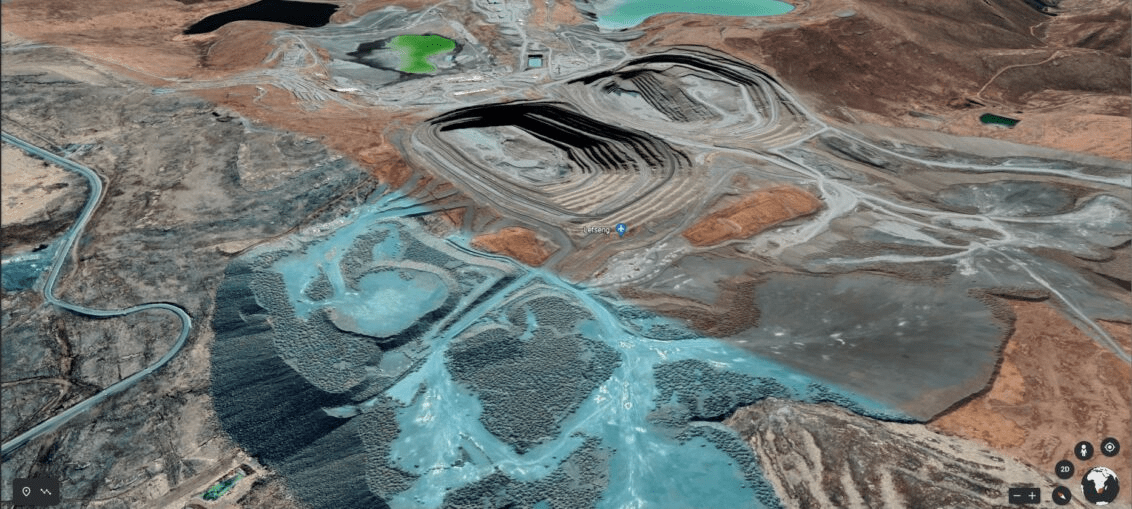Exposed: Letšeng Secretly Admits Contaminating Water Sources
16 May 2022 by Pascalinah Kabi
Bertha Foundation Fellow

A leading mining company in Lesotho, Letšeng Diamonds Mine, has admitted in confidential reports that its operations are polluting water systems that poor, rural communities rely on daily. But the company denies this in public.
The Patising and Maloraneng communities live near the mine and rely on surrounding natural water sources. Residents, who tell stories of blue and black water running in the streams they use to wash and cook with, believe this contamination is causing severe illness and death.
Letšeng Diamonds Mine, which started operating in 2004 and is owned by a London-based shareholder, Gem Diamonds (70%) as well as the Lesotho Government (30%), denies any wrongdoing and argues that they are managing pollution levels that are a by-product of their operations.
But, in a confidential report to Lesotho’s Department of Environment, seen by the MNN, the mine admits that: “Seepages from the waste rock dumps and overflows from dirty water containment facilities allow receiving surface water environments to become polluted with especially nitrates and sulphate”.
WATCH:
Chief Executive Officer of Letšeng Diamonds Mine, Kelebone Leisanyane submitted the report in January this year to the Department of Environment, under the Ministry of Tourism, Environment and Culture, in line with Environmental Act 2008.
This Annual External Social and Environmental Management Plan Compliance Audit Report, states that: “Standards for nitrate are consistently exceeding in the Patising”.
“Despite the implementation of several mitigatory measures to clean the seepage (dilution and engineered wetlands), the system remains polluted with nitrate to levels exceeding domestic and livestock guidelines.
“Standards for the nitrates are consistently exceeded in the Patising, Qaqa and RTZ systems while biomonitoring (SASS and diatoms) results show the Patising system to be in a poor condition, mostly owing to elevated salts and organic pollution (Biannual Water Quality Monitoring Report of March 2021)”.
The report further reveals that the RTZ system, a structure built to treat water in the mine, has recorded increasing levels of nitrate and sulphate since 2014, which suggests that the mine has always been fully aware of its anthropogenic impact on the Mokhotlong water sources as per the findings of this report.
In a telephonic interview with MNN, Leisanyane said: “The issue of sulphates and nitrates in a mining area is one of the things that are being managed on a regular basis because the mine uses explosives and that is something which is there”.
Section 4 of the Environment Act 2008 makes it mandatory for companies to take “all reasonable measures to mitigate undesirable effects not contemplated in the environmental impact statement and shall report those measures to the Director annually or whenever the Director requires”.
To achieve this, companies compile their Social and Environmental Management Plans (SEMP), have them externally audited and submitted to the Department of Environment whenever requested by the Director of Environment, Motsamai Damane.
In Letšeng’s case, the audit was carried out by South Africa’s environmental consultant, Shangoni Management Services. In its findings, Shangoni constantly refers to previous reports such as the March 2021 Biannual Water Quality Monitoring Report which confirms water contamination allegations against Letšeng to be true.
While Shangoni notes that there was high level of compliance on the mine’s SEMP, the consultant lists six non-compliance issues that include: “activities affecting the surrounding clean water environment through seepages and release of affected water – high nitrate and sulphate concentrations”.
Shangoni’s findings coincide with two independent research studies undertaken by the Maluti Community Development Forum (MCDF), an interest group that defends the rights of Lesotho’s poor communities in mining areas as well as a masters study by Cape Peninsula University of Technology (CPUT) student Bokang Shakhane.
The MCDF report states that: “A high concentration of nitrates (NO3) was found in water samples near tailing sites in Letšeng and Maloraneng villages”.
“While most natural streams in Lesotho have been found extremely clean in terms of water quality, nitrate levels up to 18 mg/l are not uncommon. However, the levels found in the samples from Letšeng and Maloraneng exceeded the detection limit of the measurement instrument (absorbance of 3000, equivalent to 86.18 mg/l NO3).”
The organisation says its findings were made after it engaged experts from the National University of Lesotho to scientifically test their chemical composition through Ultraviolet Visible Spectrophotometry.
Reacting to the MCDF findings on 29 March 2022, Leisanyane released a statement stating “in line with our commitment to transparency, we make regular and full disclosures to the appropriate stakeholders in Lesotho”.
The third CPUT report, by Shakhane, states that “the results indicated the concentration of nitrates/nitrites in the range from 0.13 – 167 mg/L and 0 – 67.8 mg/L during dry and wet seasons respectively”.
“The nitrates and nitrites on the other hand proved to be mainly point sources because they were highest at Patising stream which carries some effluent from Letšeng diamond slime dams,” Shakhane said.
He says ammonia, also distributed across all the sampled locations but highest at Patising still confirming the influence of the mine, ranged from 0.17 – 1.89 mg/L and 0.15 – 0.68 mg/L in the dry and wet season respectively.
Another heavy metal, copper ranged from 0.039 – 0.219 mg/L and 0.011 – 0.029 in the dry and wet season respectively while the levels of lead ranged from 0 – 0.020 mg/L and that of chromium was found to lie between 0 and 0.046 mg/L.
“The results obtained in the present study indicated that there was a definite pollution in the Khubelu River Catchment with respect to HMs (heavy metals) and nutrients studied,” Shakhane stressed that these metals can have serious health implications for both human beings as well as plants and animals.
He recommended an appropriate joint monitoring programme by the Departments of Environment and Water Affairs be done in order to minimise the possible impacts.
Leisanyane told MNN: “We are not getting into these research-related questions because we do not have time, they are highly academic”.
The big question
In September 2020, 19 Patising villagers dragged the Letšeng Diamonds Mine to court, fearing for their lives in an event a slime dam constructed by the mine, upstream of their village, collapses.
Significantly, ‘Mapontšo Lematla, one of the 19 villagers, also argued that the mine was contaminating freshwater sources. Leisanyane said water pollution allegations were misplaced when responding to a highly unusual high court application Lematla and 18 other villagers filed in court. The case is pending.
Leisanyane responded saying that: “The allegations are misplaced”
Yet the report to the Department of Environment, which Leisanyane signed off and submitted, indicates that the Patising Return Water Dam receives seepage from the Patising TSF as well as stormwater from the surrounding catchment, resulting in frequent overflow of dirty water into the catchment.
The report further states that although an access road is used as a stormwater diversion to the north of the dam, “no such attenuation or diversion structure is located south of the dam and clean water allowed to freely drain into the dam and resulting overflows from the dam into the Patising catchment”.
“As a consequence, the Patising system consistently exceeds the legal and adopted standards for nitrate”.
According to the report, the mine has always known that it was recording “increasing levels of nitrate and sulphate since 2014”.
On 20 April this year, Leisanyane told MNN sulphates and nitrates are “byproducts of our work, we monitor them on a regular basis”.
“We have to (regularly monitor them) because they are the byproducts of using explosives and all mines that use explosives do that (monitoring),” Leisanyane said.
Now the question is, did Leisanyane commit perjury when he told the court in September 2020 that the water contamination allegations were misplaced?
Minister confirms pollution
As part of a poverty mitigation strategy, the Lesotho government is currently implementing an environmental rehabilitation programme called Metseletsele which employs unskilled labour in different communities.
Forestry, Range and Soil Conservation Minister Motloli Maliehe officiated a tree-planting event held at Maloraneng for the Paea-lea-Itlhatsoa community in 2020.
“We once planted trees next to the village (Maloraneng). As we were watering (the trees), collecting water from the stream (Maloraneng) and pouring it into the tree holes, that soil changed immediately and there was a blue layer on top of it, depicting the very same blue water that we regularly witness,” Moletsane said.
Moletsane says Maliehe is well aware of their grievances with Letšeng on the water pollution saga.
“I think his surname was something like Maliehe. He is a minister responsible for the Metseletsele projects or Forestry Ministry. He took our issues and said he would engage minister of mining to see how best these issues can be handled,” Moletsane said.
In a brief interview with MNN, Maliehe confirmed that he saw the blue water in Maloraneng stream.
“Yes, I agree that I witnessed the water contamination with my own eyes but that is not my responsibility (to deal with this issue at ministerial level), the ministry responsible is that of environment,” Maliehe said.
Who is fooling who?
According to Shangoni Management Services, the mine supplies water to communities whose surface water is contaminated by its activities.
“Letšeng supplies water to two communities where surface water sources are contaminated with nitrate to the extent that it is unusable for drinking water,” Shangoni Management Services said in a leaked report the mine submitted to the Department of Environment.
In Patising alone, the mine yielded to community pressure and constructed a solar-powered water project pumping water from the Khubelu River into a tank for purification.
Leisanyane says the mine supplies potable water to the communities if “we are not happy” with the level of nitrate and sulphate in the water. He says this particularly happens during drought seasons.
“If we discover that our own set standards, which are way above the South African standards because Lesotho does not own country standards, are at the level which does not make us happy, indeed we supply them with water different from that they would be using because we must live and there is nothing we can do,” Leisanyane said.
This is however contrary to the public position Letšeng has always taken on water contamination allegations. Denial, denial.
Shangoni has since advised Letšeng to “continue with current investigation and studies linked to the bioremediation plan for surface water pollutants”.
The solar-powered system has collapsed due to overflowing Khubelu River and in 2022, Letšeng Diamonds Mine succummed to mounting pressure from the Patising villagers and constructed a borehole in Patising.
This story was produced and first published by MNN Centre for Investigative Journalism.


